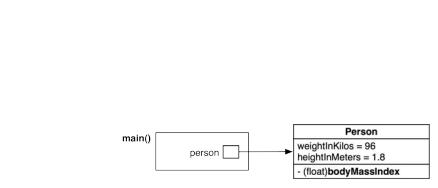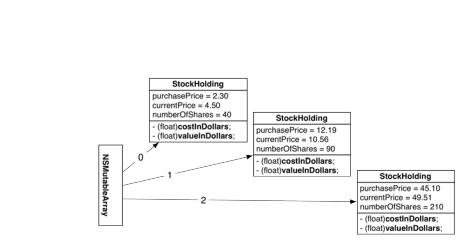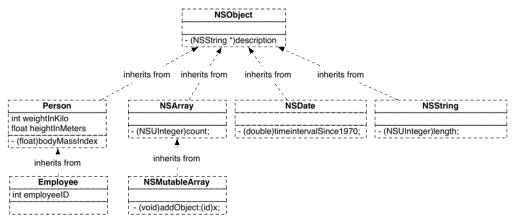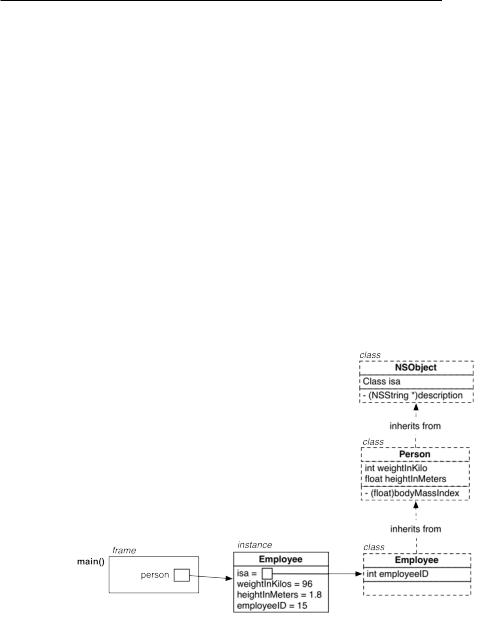
- •C and Objective-C
- •How this book works
- •How the life of a programmer works
- •Installing Apple’s developer tools
- •Getting started with Xcode
- •Where do I start writing code?
- •How do I run my program?
- •So what is a program?
- •Don’t stop
- •Types
- •A program with variables
- •Challenge
- •Boolean variables
- •When should I use a function?
- •How do I write and use a function?
- •How functions work together
- •Local variables, frames, and the stack
- •Recursion
- •Looking at the frames in the debugger
- •return
- •Global and static variables
- •Challenge
- •printf()
- •Integer operations
- •Integer division
- •Operator shorthand
- •Floating-point numbers
- •Tokens for displaying floating-point numbers
- •The while loop
- •The for loop
- •break
- •continue
- •The do-while loop
- •Challenge
- •Getting addresses
- •Storing addresses in pointers
- •Getting the data at an address
- •How many bytes?
- •NULL
- •Stylish pointer declarations
- •Challenges
- •Writing pass-by-reference functions
- •Avoid dereferencing NULL
- •Creating and using your first object
- •Message anatomy
- •Objects in memory
- •Challenge
- •Nesting message sends
- •Multiple arguments
- •Sending messages to nil
- •Challenge
- •Challenge
- •NSMutableArray
- •Reference pages
- •Quick Help
- •Other options and resources
- •Accessor methods
- •Dot notation
- •Properties
- •self
- •Multiple files
- •Challenge
- •Overriding methods
- •super
- •Challenge
- •Object ownership and ARC
- •Creating the Asset class
- •Adding a to-many relationship to Employee
- •Challenge
- •Retain cycles
- •Weak references
- •Zeroing of weak references
- •For the More Curious: Manual reference counting and ARC History
- •Retain count rules
- •NSArray/NSMutableArray
- •Immutable objects
- •Sorting
- •Filtering
- •NSSet/NSMutableSet
- •NSDictionary/NSMutableDictionary
- •Preprocessor directives
- •#include and #import
- •#define
- •Global variables
- •enum
- •#define vs global variables
- •Writing an NSString to a file
- •Reading files with NSString
- •Writing an NSData object to a file
- •Reading an NSData from a file
- •Target-action
- •Helper objects
- •Notifications
- •Which to use?
- •Callbacks and object ownership
- •Challenge
- •Getting started with iTahDoodle
- •BNRAppDelegate
- •Adding a C helper function
- •Objects in iTahDoodle
- •Model-View-Controller
- •The application delegate
- •Setting up views
- •Running on the iOS simulator
- •Wiring up the table view
- •Adding new tasks
- •Saving task data
- •For the More Curious: What about main()?
- •Edit BNRDocument.h
- •A look at Interface Builder
- •Edit BNRDocument.xib
- •Making connections
- •Revisiting MVC
- •Edit BNRDocument.m
- •Writing init methods
- •A basic init method
- •Using accessors
- •init methods that take arguments
- •Deadly init methods
- •Property attributes
- •Mutability
- •Lifetime specifiers
- •copy
- •More about copying
- •Advice on atomic vs. nonatomic
- •Key-value coding
- •Non-object types
- •Defining blocks
- •Using blocks
- •Declaring a block variable
- •Assigning a block
- •Passing in a block
- •typedef
- •Return values
- •Memory management
- •The block-based future
- •Challenges
- •Anonymous block
- •NSNotificationCenter
- •Bitwise-OR
- •Bitwise-AND
- •Other bitwise operators
- •Exclusive OR
- •Complement
- •Left-shift
- •Right-shift
- •Using enum to define bit masks
- •More bytes
- •Challenge
- •char
- •char *
- •String literals
- •Converting to and from NSString
- •Next Steps
- •Index

Accessor methods
Build and run the program. Notice that you imported Person.h so that the compiler will know how your methods are declared before they are used in main().
Figure 17.1 Object diagram for BMITime
Accessor methods
Note that when we did this same exercise with structs instead of objects, we accessed the data members of the structure directly in main():
person.weightInKilos = 96; person.heightInMeters = 1.8;
In object-oriented thinking, we do our best to keep the instance variables of an object private; that is, they are known and accessed only by the object itself. However, because we want to give methods and functions outside of Person the ability to set a person’s weight and height, we created the methods setWeightInKilos: and setHeightInMeters:. We call these setter methods.
A setter method allows other methods to set the value of an instance variable. A getter method allows other methods to read the value of an instance variable. Setter and getter methods are also known as accessor methods, or just accessors.
Add declarations for the getter methods to Person.h:
#import <Foundation/Foundation.h>
@interface Person : NSObject
{
float heightInMeters; int weightInKilos;
}
// You will be able to set those instance variables
-(float)heightInMeters;
-(void)setHeightInMeters:(float)h;
-(int)weightInKilos;
-(void)setWeightInKilos:(int)w;
-(float)bodyMassIndex;
@end
You might wonder why the names of the getter methods don’t include get to match the setter method names. This is an Objective-C naming convention. The name of the method for reading an instance variable is simply the name of that instance variable.
Now return to Person.m and implement your getter methods:
103

Chapter 17 Your First Class
@implementation Person
-(float)heightInMeters
{
return heightInMeters;
}
-(void)setHeightInMeters:(float)h
{
heightInMeters = h;
}
-(int)weightInKilos
{
return weightInKilos;
}
-(void)setWeightInKilos:(int)w
{
weightInKilos = w;
}
-(float)bodyMassIndex
{
return weightInKilos / (heightInMeters * heightInMeters);
}
@end
Finally, in main.m, use those methods:
#import "Person.h"
int main(int argc, const char * argv[])
{
@autoreleasepool {
// Create an instance of Person
Person *person = [[Person alloc] init];
//Give the instance variables interesting values [person setWeightInKilos:96];
[person setHeightInMeters:1.8];
//Call the bodyMassIndex method
float bmi = [person bodyMassIndex];
NSLog(@"person (%d, %f) has a BMI of %f",
[person weightInKilos], [person heightInMeters], bmi);
}
return 0;
}
Build and run the program.
Dot notation
Objective-C programmers call accessor methods a lot. Apple decided to create a shortcut for calling an accessor. This shortcut makes these two lines of code exactly the same:
104

Properties
p = [x fido]; p = x.fido;
It also makes these two lines of code exactly the same:
[x setFido:3]; x.fido = 3;
The form that uses the period instead of the square brackets is known as dot notation.
I avoid using dot notation. I feel it obscures the fact that a message is being sent, and it isn’t consistent with the way we do every other message send in the system. You are welcome to use dot notation, but it will not appear anywhere else in this book.
Properties
Notice that most of our code in the Person class is devoted to accessor methods. Apple has created a handy way to simplify writing accessor methods called properties. With a property, you can declare both the setter and getter methods in one line.
In Person.h, replace the declaration of the setter and getter methods with the @property construct:
#import <Foundation/Foundation.h>
@interface Person : NSObject
{
float heightInMeters; int weightInKilos;
}
@property float heightInMeters; @property int weightInKilos;
- (float)bodyMassIndex; @end
You have not changed this class at all with this edit. You are just using a terser syntax.
Now, take a look at the Person.m file. It is chock-full of simple and predictable accessor methods. In the case where your accessors do nothing special, you can just tell the compiler to synthesize default accessor methods based on each @property declaration. Delete the accessors and replace them with a call to @synthesize:
#import "Person.h"
@implementation Person
@synthesize heightInMeters, weightInKilos;
- (float)bodyMassIndex
{
return weightInKilos / (heightInMeters * heightInMeters);
}
@end
Build and run the program. Everything should work the same as before with code that is far simpler and easier to maintain.
105

Chapter 17 Your First Class
self
Inside any method, you have access to the implicit local variable self. self is a pointer to the object that is running the method. It is used when an object wants to send a message to itself. For example, many Objective-C programmers are quite religious about accessor methods; they never read or write to an instance variable except using its accessor methods. Update your bodyMassIndex method to please the purists:
- (float)bodyMassIndex
{
float h = [self heightInMeters]; return [self weightInKilos] / (h * h);
}
Here an instance of Person sends itself two messages, heightInMeters and weightInKilos, to get the values of its instance variables.
You can also pass self as an argument to let other objects know where the current object is. For example, your Person class might have a method addYourselfToArray: that would look like this:
- (void)addYourselfToArray:(NSMutableArray *)theArray
{
[theArray addObject:self];
}
Here you use self to tell the array where the instance of Person lives. It is literally its address.
Multiple files
Notice that your project now has executable code in two files: main.m and Person.m. (Person.h is a declaration of a class, but there is no executable code in it.) When you build the project, these files are compiled separately and then linked together. It is not uncommon that a real-world project will consist of hundreds of files of C and Objective-C code.
You can also link in libraries of code. For example, you might find a great library for parsing data from digital telescopes on the Internet. If your program needed this capability, you would compile that library and add it to your project. When Xcode built your program, it would link in all the functions and classes defined in that library.
Challenge
Create new Foundation Command Line Tool called Stocks. Then create a class called StockHolding to represent a stock that you have purchased. It will be a subclass of NSObject. For instance variables,
it will have two floats named purchaseSharePrice and currentSharePrice and one int named numberOfShares. Create accessor methods for the instance variables. Create two other instance methods:
- |
(float)costInDollars; // |
purchaseSharePrice * numberOfShares |
- |
(float)valueInDollars; // |
currentSharePrice * numberOfShares |
In main(), fill an array with three instances of StockHolding. Then iterate through the array printing out the value of each.
106

Challenge
Figure 17.2 An array of StockHolding objects
107
This page intentionally left blank

18
Inheritance
When you created the Person class, you declared it to be a subclass of NSObject. This means that every instance of Person will have the instance variables and methods defined in NSObject as well as the instance variables and methods defined in Person. We say that Person inherits the instance variables and methods from NSObject. In this section, we are going to delve a bit into inheritance.
Open up the BMITime project and create a new file: an Objective-C class. Name it Employee and create it as a subclass of NSObject. Soon, we will change the Employee class to be a subclass of Person. Makes sense, right? Employees are people. They have heights and weights. However, not all people are employees. We’ll also add an employee-specific instance variable to our class – an employee ID.
Figure 18.1 Inheritance diagram of some classes you know
Open Employee.h. Import Person.h, change the superclass to Person, and add an instance variable to hold the employee’s ID number:
#import "Person.h"
@interface Employee : Person
{
int employeeID;
}
@property int employeeID;
@end
109

Chapter 18 Inheritance
Open Employee.m and synthesize the accessors:
#import "Employee.h" @implementation Employee
@synthesize employeeID;
@end
Now you have a new Employee class with all the instance variables of Person and a new instance variable called employeeID. Instances of Employee will respond to all the same messages that an instance of Person will. Instances of Employee will also respond to the messages setEmployeeID:
and employeeID.
And, because Person inherits from NSObject, Employee also inherits all the instance variables and methods from NSObject. All objects inherit (either directly or indirectly) from NSObject.
NSObject has many methods, but only one instance variable: the isa pointer. Every object’s isa pointer points back to the class that created it.
Figure 18.2 Object diagram for BMITime
Let’s say that you send the message fido to an object. In order to respond to this message, the object uses the isa pointer to find its class and ask, “Do you have an instance method named fido?” If the class has a method named fido, it gets executed. If the class doesn’t have a fido method, it asks its superclass, “Do you have an instance method called fido?” And up, up the chain it goes on the hunt for a method named fido. The hunt stops when the method is found or when the top of the chain
is reached. At the top of the chain, NSObject says, “Nope, no fido method.” Then you get an error message that says something like “This instance of Employee does not respond to the fido selector.”
110

Try it. Open up main.m and send the instance of Person a message it won’t understand:
int main(int argc, const char * argv[])
{
@autoreleasepool {
// Create an instance of Person
id person = [[Person alloc] init];
//Give the instance variables interesting values [person setWeightInKilos:96];
[person setHeightInMeters:1.8];
//Call the bodyMassIndex method
float bmi = [person bodyMassIndex]; NSLog(@"person (%d, %f) has a BMI of %f",
[person weightInKilos], [person heightInMeters], bmi);
[person count];
}
return 0;
}
Build and run the program. (Ignore the warning from the compiler because you’re doing this on purpose. In most cases, you’ll want to pay attention to this warning if you see it!) You should see a runtime exception logged to the console:
***Terminating app due to uncaught exception 'NSInvalidArgumentException', reason: '-[Person count]: unrecognized selector sent to instance 0x100108de0'
After examining the exception, delete the problematic line before continuing.
You’ve created this new Employee class, but you haven’t used it yet. Change main.m to use Employee:
#import <Foundation/Foundation.h>
#import "Employee.h"
int main(int argc, const char * argv[])
{
@autoreleasepool {
// Create an instance of Person
Person * person = [[Employee alloc] init];
//Give the instance variables interesting values [person setWeightInKilos:96];
[person setHeightInMeters:1.8];
//Call the bodyMassIndex method
float bmi = [person bodyMassIndex]; NSLog(@"person (%d, %f) has a BMI of %f",
[person weightInKilos], [person heightInMeters], bmi);
}
return 0;
}
Notice that your person variable is still declared as a pointer to a Person. Think this will cause a problem? Build and run the program, and you’ll see that your program still works fine. This is because
111
